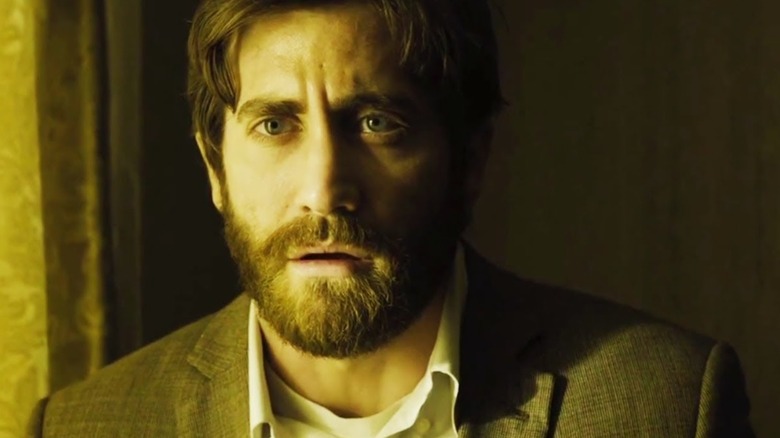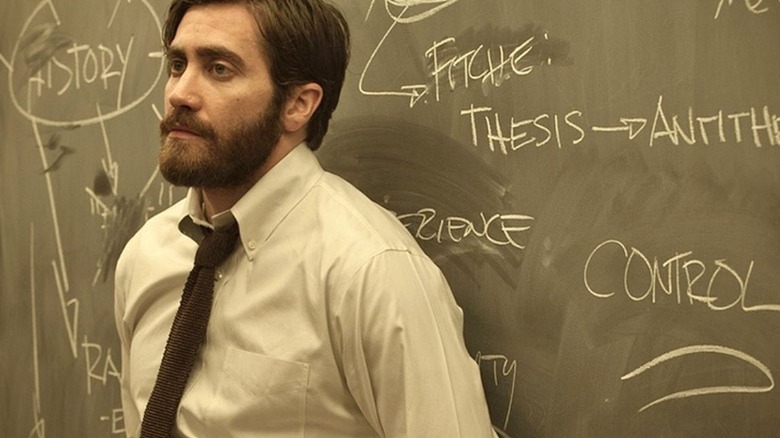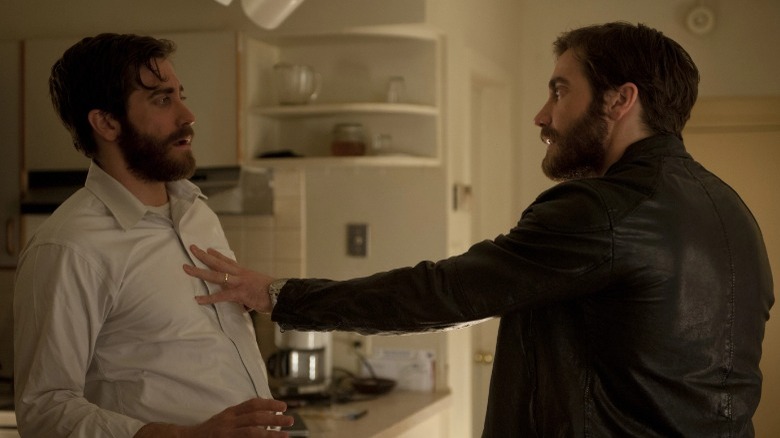Denis Villeneuve Pushed Jake Gyllenhaal's Acting To The 'Verge Of Chaos' While Filming Enemy
Denis Villeneuve rarely misses. The director has a penchant for crafting thrillingly intricate character studies, incorporated in a range of films from "Prisoners," to "Blade Runner 2049." However, his 2013 psychological drama, "Enemy," is perhaps Villeneuve's most psychologically dense work, which takes on an extremely Kafkaesque tint and is more concerned with the subconscious, as opposed to objective reality. With an ending that warrants reactions along the lines of "what the heck does that even mean?" "Enemy" directly challenges the viewer to exercise their ability to parse and interpret the film's text and subject. Most of what happens to the film's dual (?) protagonists Adam and Anthony (both played by Jake Gyllenhaal) is up to interpretation, along their journeys and whether these dual identities truly exist.
Gyllenhaal's portrayal of the film's central twins is nothing short of brilliant, with the actor having to switch his demeanor in extremely subtle, yet telling ways. In the first half of the film, Adam, who is a mild-mannered professor, is mistaken for the blunt, brash Anthony several times, which blurs the lines of identity and control, giving way to obsession. There's a considerable amount of stalking from both parties, and the narrative quickly devolves into chaos, with Gyllenhaal's Adam and Anthony at the heart of the maze. In order to inspire a chaotic, riveting performance from Gyllenhaal, Villeneuve took the Kubrickian, 'multiple takes' route while pushing the limits of the characters as much as possible. How did he manage to do that?
A collaborative process
In an interview with Vodzilla, Denis Villeneuve explained the creative process while shooting most of "Enemy," which involved tons of improvisation and "a controlled environment" where the actors, particularly Jake Gyllenhaal, could safely arrive at breakthrough character moments. While there was freedom to improvise, a lot of the script was painstakingly structured, adding precision to the characters and their motivations. Essentially, there is a method to the madness on a Denis Villeneuve set, which allowed him and cinematographer Nicolas Bolduc to work closely with the actors. He said:
"Most of the movie is shot in a studio, a very controlled environment ... the scenes were very precise, but I wanted to improvise with the actors a lot and I did tons of takes. I was doing 25, 35, 40 takes with Jake Gyllenhaal trying to explore a deeper approach, to go in the verge of chaos and find a new way of acting. For that, I decided there would be no marks on the floor, the actors would be free in the environment and we worked with a little crane that was able to follow their movements."
Instead of fostering an environment in which actors need to follow precise directorial instructions and unwillingly participate in several takes, Villeneuve made sure that there was ample room for collaboration and creative breakthrough. As the camera mostly followed Gyllenhaal, the scenes were lit in a way that allowed him to "find [his] own light," granting him agency in terms of character portrayal. Moreover, while the storytelling was minutely controlled by Villeneuve, he was open to "exploring new ways of directing" when it came to collaborating with Gyllenhaal and the rest of the actors. This balanced process, which encouraged both structure and lawlessness, allowed "Enemy" to morph into the intellectually-stimulating fever dream of a movie it is.
How Gyllenhaal enriches the Adam/Anthony dichotomy
There are several ways of interpreting the mad dance of power and control in "Enemy," which serves as the foundation of the relationship between Adam and Anthony. Due to the eerie, mirrored nature of their dynamic, where the reflections seem identical but couldn't be more dissimilar, the film adopts a surreal, oppressive nature that feels alien to everyday life. Irrespective of how one chooses to interpret the narrative, Jake Gyllenhaal's portrayal of Adam/Anthony is so effective that it is difficult to come to the conclusion of whether they're two separate entities or represent two sides of the same persona. One can argue in favor of either theory, thanks to Gyllenhaal's dynamic, subtly powerful performance where he emotes mostly with his body language.
In the same interview linked above, Denis Villeneuve delved into how he made sure that Gyllenhaal had access to "a laboratory, a safe space" on set where he could experiment, make mistakes, and explore new pathways. This kind of secure, no-limits environment urged Gyllenhaal to approach his dual characters with nuance, and the results, in Villeneuve's own words, were "a success:"
"We [he and Gyllenhaal] had so much fun and decided to apply those techniques to a classic studio movie and it was, for us, a success...It's really a nice creative collaboration."
The opening line of the film, "Chaos is order yet undeciphered," is a reference to José Saramago's novel "The Double," on which Villeneuve's adaptation is based. Interestingly, the sentiment of this quote seems to have been adopted by the director, which served him and his cast well in terms of making a film so imbued with layered intricacy and general mindf***ery. "Enemy" remains deliciously indecipherable to this day, and manages to evoke feelings of anxiety connected to self-perception.


